Menu
Physics Lesson 6.8.3 - Explosions
Please provide a rating, it takes seconds and helps us to keep this resource free for all to use
Welcome to our Physics lesson on Explosions, this is the third lesson of our suite of physics lessons covering the topic of Momentum and Impulse in Two Dimensions. Explosions., you can find links to the other lessons within this tutorial and access additional physics learning resources below this lesson.
Explosions
Explosions are the reverse phenomenon of inelastic collisions. Thus, in inelastic collisions the kinetic energy converts into other form after the impact, while in explosions, the energy stored in the object converts into kinetic energy, making it move faster than before. Therefore, the equation of explosions is the inverse of that used in inelastic collisions.
where M is the mass of the original object, m1 and m2 are the masses of the respective pieces after the explosion, v0 is the initial velocity of the original object before the explosion, v1 and v2 are the velocities of the pieces after the explosion.
The simplest case of explosions is when the original object explodes and splits in two pieces which move in opposite directions as shown in the figure.
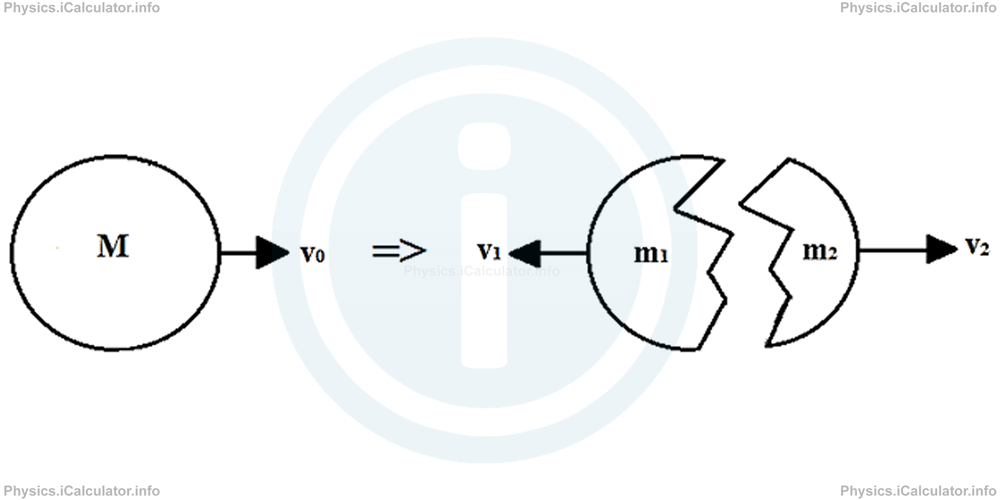
In this case, we have only one dimension involved and therefore, a single equation to write (the equation of explosions written above). Let's consider an example to explain this point.
Example 2
A 5 kg ball is moving initially due right at 1 m/s. The ball explodes due to an internal process and as a result, it divides in two pieces at ratio 3:2 between them. After explosion, the smallest piece contine moving in the original direction at 15 m/s. What is the velocity (and the direction) of the largest piece after the explosion?
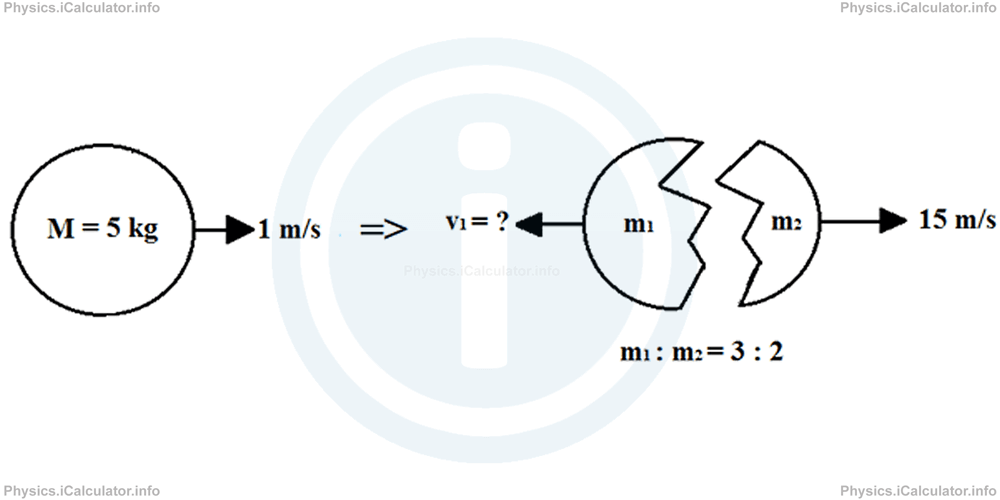
Solution 2
First let's work out the masses of the two pieces after the explosion. We have the ratio
This means m1 = 3x and m2 = 2x (where x is a constant).
Also, we have m1 + m2 = 5 kg.
Therfore, we can write
5x = 5 kg
x = 1 kg
Thus,
and
Now, applying the equation
where M = 5 kg, v⃗0 = 1 m/s and v⃗1 = 15 m/s, we find for the velocity v⃗2 of the second piece after the explosion,
5 = 3 × v⃗1 + 30
- 25 = 3 × v⃗1
v⃗2 = - 25/3 m/s ≈ - 8.33 m/s
This result means the larger piece will move at 8.33 m/s in the opposite direction as it was before the explosion, i.e. due left.
Explosions in Two Dimensions
In explosions in two dimensions, we use the same approach as for momentum and impulse in two dimensions, i.e. we write the equation of momentum conservation for each direction separately. We have
For illustration, let's consider an example where an object explodes and divides in three pieces.
Example 3
A 12 kg object moving at 3 m/s due right - as shown in the figure below - explodes in three pieces, which have a ratio of 2:1:3 between them.
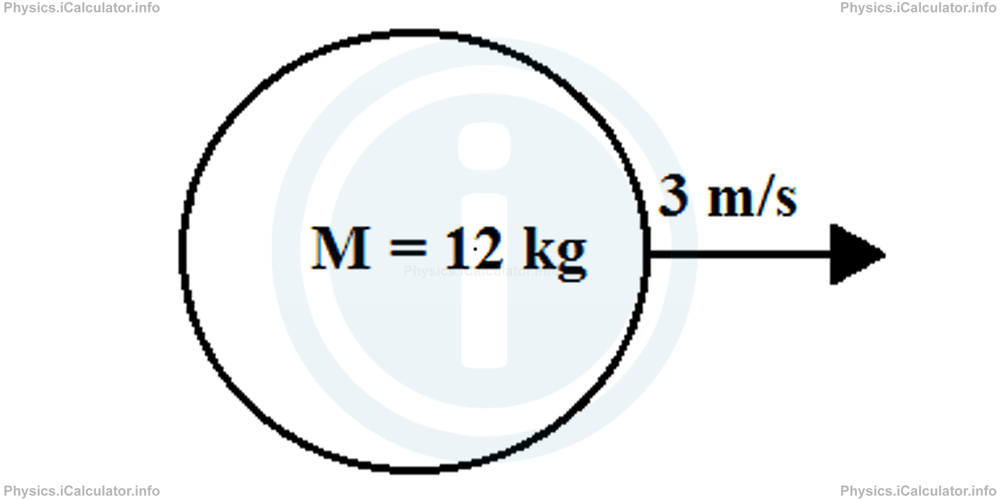
After the explosion, the first piece moves at 8 m/s up, the second piece (the smallest) moves at 40 m/s due right (in the same direction it was moving before the explosion).
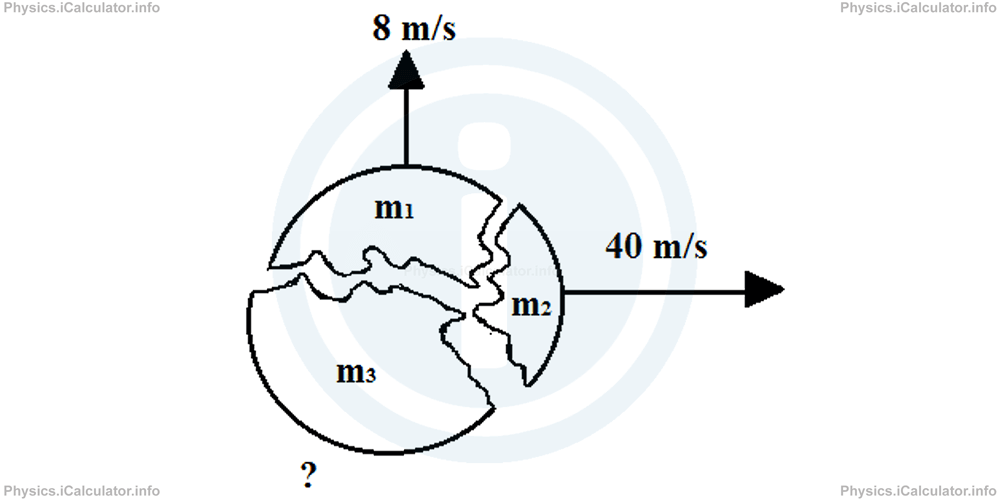
Calculate:
- The velocity components of the largest piece after the explosion
- Magnitude of velocity of the largest piece after the explosion
- The angle formed by the largest piece to the left-right direction after the explosion
- What happens with the kinetic energy of the object after the explosion? Explain.
Solution 3
First, let's calculate the masses of the three pieces after the explosion. Giving that the total mass of the original object was M = 12 kg, we have
and
From the first equation, we obtain
m2 = 1x
m3 = 3x
where x is a constant. Substituting them in the second equation, we obtain
6x = 12 kg
x = 2 kg
Therefore,
m2 = 1x = 1 × 2 kg = 2 kg
m3 = 3x = 3 × 2 kg = 6 kg
We can take the let-to-right as positive of x-direction and down-to-up as positive of y-direction (as usual). Therefore, the other clues of this problem are:
v0y = 0
v1x = 0
v1y = 8 m/s
v2x = 40 m/s
v2y = 0
v3x = ?
v3y = ?
Applying the law of conservation of momentum for two dimensions,
we obtain after the substitutions
-44 = 6 × v⃗3x
v⃗3x = -7.3 m/s
12 × 0 = 4 × 8 + 2 × 0 + 6 × v⃗3y
-32 = 6 × v⃗3x
v⃗3y = -5.3 m/s
This means the third and largest piece will move at 7.3 m/s left and 5.3 m/s down after the explosion as shown in the figure below.
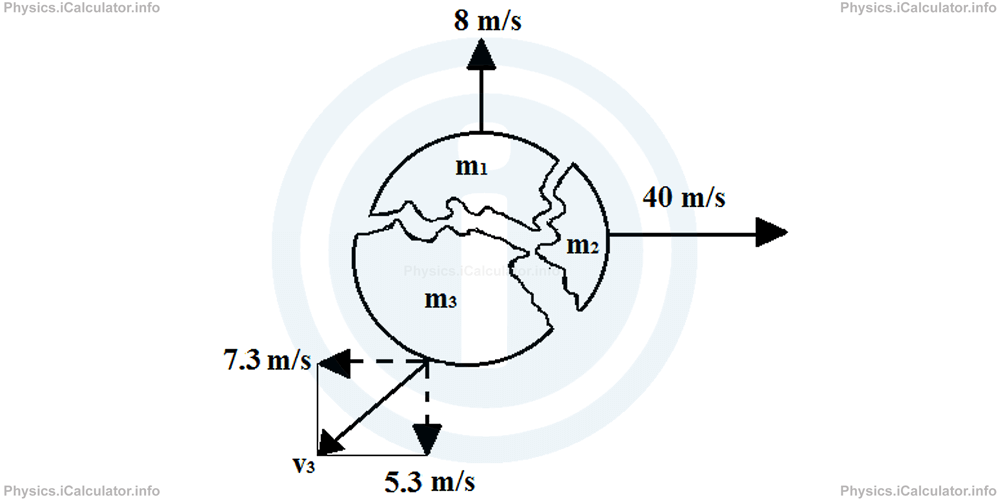
b. |v⃗3 | = ?
Magnitude of the velocity of the largest piece after explosion is
= √(-7.3)2 + (-5.3)2
= √53.3 + 28.1
= √82
= 9.1 m/s
c. We have to calculate the size of the wide angle θ formed by the third piece velocity vector and the left-to-right direction. We have:
= tan-1 -5.3 m/s/-7.3 m/s
= 36° or 180° + 36°
= 216°
We consider only the second value as the angle θ is wide as shown in the figure.
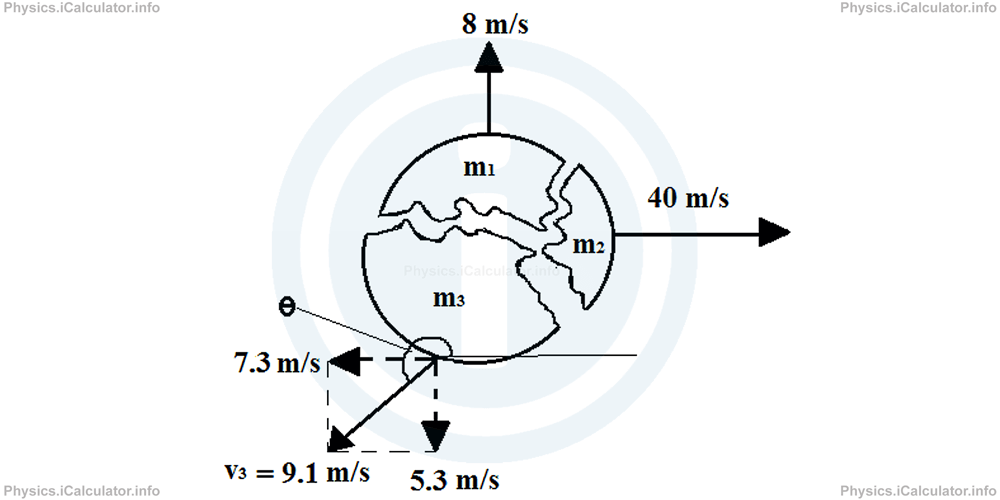
d. The initial velocity of the object before explosion was directed only according the x-direction. Therefore, v0 = v0x = 3 m/s.
Kinetic energy of the object before the explosion therefore was
On the other hand, giving that v1 = v1y = 8 m/s, v2 = v2x = 40 m/s and v3 = 13.6 m/s (as foud earlier), the kinetic energy of each piece after the explosion is
KE2 = m1 × v22/2 = 2 × 402/2 = 1600 J
KE3 = m1 × v23/2 = 6 × 82/2 = 246 J
Therefore, the total kinetic energy KE of the system after the explosion is
= 128 J + 1600 J + 246 J
= 1974 J
Obviously, this value is much gretaer than the initial kinetic energy of the object before expoding. This means some of the stored (idle) energy of the object has been activated and it was converted into kinetic energy during the explosion. Therefore, there is no break in the energy conversion law discusses in the previous articles.
You have reached the end of Physics lesson 6.8.3 Explosions. There are 3 lessons in this physics tutorial covering Momentum and Impulse in Two Dimensions. Explosions., you can access all the lessons from this tutorial below.
More Momentum and Impulse in Two Dimensions. Explosions. Lessons and Learning Resources
Whats next?
Enjoy the "Explosions" physics lesson? People who liked the "Momentum and Impulse in Two Dimensions. Explosions. lesson found the following resources useful:
- Explosion Feedback. Helps other - Leave a rating for this explosion (see below)
- Centre of Mass and Linear Momentum Physics tutorial: Momentum and Impulse in Two Dimensions. Explosions.. Read the Momentum and Impulse in Two Dimensions. Explosions. physics tutorial and build your physics knowledge of Centre of Mass and Linear Momentum
- Centre of Mass and Linear Momentum Revision Notes: Momentum and Impulse in Two Dimensions. Explosions.. Print the notes so you can revise the key points covered in the physics tutorial for Momentum and Impulse in Two Dimensions. Explosions.
- Centre of Mass and Linear Momentum Practice Questions: Momentum and Impulse in Two Dimensions. Explosions.. Test and improve your knowledge of Momentum and Impulse in Two Dimensions. Explosions. with example questins and answers
- Check your calculations for Centre of Mass and Linear Momentum questions with our excellent Centre of Mass and Linear Momentum calculators which contain full equations and calculations clearly displayed line by line. See the Centre of Mass and Linear Momentum Calculators by iCalculator™ below.
- Continuing learning centre of mass and linear momentum - read our next physics tutorial: Torque
Help others Learning Physics just like you
Please provide a rating, it takes seconds and helps us to keep this resource free for all to use
We hope you found this Physics lesson "Momentum and Impulse in Two Dimensions. Explosions." useful. If you did it would be great if you could spare the time to rate this physics lesson (simply click on the number of stars that match your assessment of this physics learning aide) and/or share on social media, this helps us identify popular tutorials and calculators and expand our free learning resources to support our users around the world have free access to expand their knowledge of physics and other disciplines.